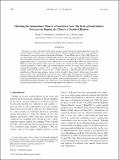Modeling the Summertime Climate of Southwest Asia: The Role of Land Surface Processes in Shaping the Climate of Semiarid Regions
Author(s)
Marcella, Marc Pace; Eltahir, Elfatih A. B.
DownloadMarcella-2012-Modeling the Summert.pdf (5.017Mb)
PUBLISHER_POLICY
Publisher Policy
Article is made available in accordance with the publisher's policy and may be subject to US copyright law. Please refer to the publisher's site for terms of use.
Terms of use
Metadata
Show full item recordAbstract
Presented is a study on the role of land surface processes in determining the summertime climate over the semiarid region of southwest Asia. In this region, a warm surface air temperature bias of 3.5°C is simulated in the summer by using the standard configuration of Regional Climate Model version 3 (RegCM3). Biases are also simulated in surface albedo (underestimation), shortwave incident radiation (overestimation), and vapor pressure (underestimation). Based on satellite measurements documented in NASA’s surface radiation budget (SRB) dataset, a correction in surface albedo by 4% is introduced in RegCM3 to match the observed SRB data. Increasing albedo values results in a nearly 1°C cooling over the region. In addition, by incorporating RegCM3’s dust module and including subgrid variability for surface wind, shortwave incident radiation bias originally of about 45 W m[superscript −2] is reduced by 30 W m[superscript −2]. As a result, the reduction of shortwave incident radiation cools the surface by 0.6°C. Finally, including a representation for the irrigation and marshlands of Mesopotamia produces surface relative humidity values closer to observations, thus eliminating a nearly 5-mb vapor pressure dry bias over some of the region. Consequently, the representation of irrigation and marshlands results in cooling of nearly 1°C in areas downwind of the actual land-cover change. Along with identified biases in observational datasets, these combined processes explain the 3.5°C warm bias in RegCM3 simulations. Therefore, it is found that accurate representations of surface albedo, dust emissions, and irrigation are important in correctly modeling summertime climates of semiarid regions.
Date issued
2012-01Department
Massachusetts Institute of Technology. Department of Civil and Environmental EngineeringJournal
Journal of Climate
Publisher
American Meteorological Society
Citation
Marcella, Marc P., and Elfatih A. B. Eltahir. “Modeling the Summertime Climate of Southwest Asia: The Role of Land Surface Processes in Shaping the Climate of Semiarid Regions.” Journal of Climate 25.2 (2012): 704–719. © 2012 American Meteorological Society
Version: Final published version
ISSN
0894-8755
1520-0442